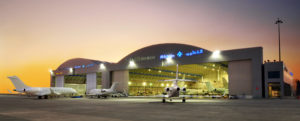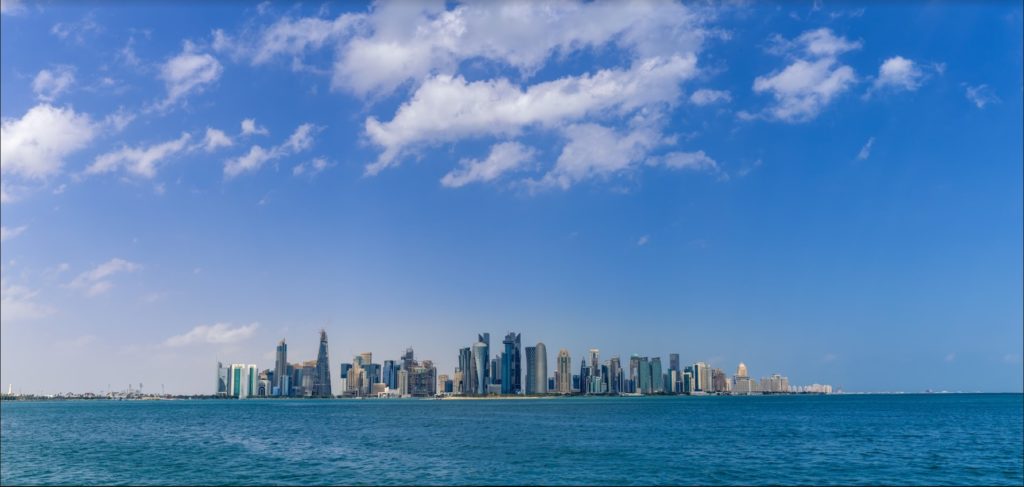Words by Chris Anderson
The fact that the FIFA World Cup will take place in Qatar later this year has been met with excitement, bemusement, protest and suspicion in equal measure. On the one hand, this will be the first time the competition has taken place in the Middle East, but with high temperatures, a population of just under 3 million, and no real football heritage to speak of, can this tiny Muslim state actually be taken seriously? With FIFA making headlines for corruption in recent years, can that really be ruled out? And Qatar’s treatment of the migrant workers building its eight stadiums has also been under the spotlight.
This is a winter World Cup to cope with the intense heat as much as possible, beginning on November 20, ending December 18, with the country set to welcome around 1.2 million visitors. Much of the infrastructure in and around the capital, and only major city, Doha, has been improved, with a new metro system to move fans between stadiums. Alcohol will also be available in select areas at each venue, as well as a special 40,000-capacity fan zone in Doha’s Al Bidda Park. It marks a significant relaxing of the country’s rules, with the event’s CEO, Nasser Al Khater, telling the BBC in September that they are still “finalizing our
alcohol strategy”.
 But this is a major event, predicted to generate US$4 billion in revenues across the Middle East. Hospitality, food and beverage, merchandise and fashion are expected to be the biggest beneficiaries, according to market research conducted by the Dubai office of RedSeer Strategic Consulting. “Though Qatar will corner the lion’s share – about 85% – of the predicted revenue from the World Cup-related spends by tourists, the UAE, especially Dubai, will be the second-biggest beneficiary during the period,” the organization said in a statement.
But this is a major event, predicted to generate US$4 billion in revenues across the Middle East. Hospitality, food and beverage, merchandise and fashion are expected to be the biggest beneficiaries, according to market research conducted by the Dubai office of RedSeer Strategic Consulting. “Though Qatar will corner the lion’s share – about 85% – of the predicted revenue from the World Cup-related spends by tourists, the UAE, especially Dubai, will be the second-biggest beneficiary during the period,” the organization said in a statement.
This also means an opportunity for private aviation in the region, flying fans in and out of Doha for games, with some customers basing themselves in Dubai for example, as a city with greater hotel options and more relaxed rules around alcohol.
Hamad International Airport is Qatar’s main entry point, but the older Doha International Airport will be given an enhanced role for the World Cup, handling additional traffic, namely governmental and private flights. Both airports have capacity for private aviation, with FBOs and other facilities.
Meeting demand
 Many private jet companies in the region are already witnessing demand for flights, and tailoring their offering for football fans. RoyalJet, headquartered in Abu Dhabi, the UAE capital, is among those offering match day flights. Mohammed Husain Ahmed, RoyalJet CEO, says, “We really want to facilitate people to travel to Doha to enjoy and celebrate the event with their friends and families, and there’s no better way to do this than fly private with your loved ones and create some beautiful memories together. We therefore decided to launch match day flights to cater to our football fans who prefer to fly private, and we’re confident of a wonderful response.”
Many private jet companies in the region are already witnessing demand for flights, and tailoring their offering for football fans. RoyalJet, headquartered in Abu Dhabi, the UAE capital, is among those offering match day flights. Mohammed Husain Ahmed, RoyalJet CEO, says, “We really want to facilitate people to travel to Doha to enjoy and celebrate the event with their friends and families, and there’s no better way to do this than fly private with your loved ones and create some beautiful memories together. We therefore decided to launch match day flights to cater to our football fans who prefer to fly private, and we’re confident of a wonderful response.”
For Tom Murphy, head of FBOs and aircraft management specialist at Gama Aviation, which has an FBO in Sharjah, a city close to Dubai, incentives and being aware of Qatar’s guidelines will be essential. “Our FBO is an alternative for those flying into Dubai, with the airport in Sharjah a little quieter, so you tend to get through a bit quicker,” he says. “We’ll be starting a World Cup promotion offering free parking, and we’ve had a lot on enquiries around the games so far – a real mixed bag of business jets and commercial aircraft looking to base themselves here, flying back and forth to Qatar, and then the business jets are either operators chartering the aircraft or private owners looking to go to the tournament.
“But you need to be aware of the guidelines Qatar has released. New rules for operation will be in place from October 30 until December 25, and there’s a US$5,000 application deposit for slots, with a US$5,000 fine for violations, and a US$25,000 fine for a cancellation within 24 hours. Another US$5,000 fine applies for AC-type violations (higher ICAO category than approved), with no overnight parking possible, and 72 hours’ minimum notice needed before a flight. And if the aircraft doesn’t meet the MRO maintenance capabilities of the airport, then you must fly over with your own engineer – hiring one will, of course, add to the overall costs.”
Such guidelines around a large event like the World Cup are not uncommon, but it remains to be seen how this might affect traffic. Issa Zuriqi, commercial director at Hadid International Services, which offers charter flights in the region, says that football fans won’t be deterred.
 “We’ve seen an increase in enquiries related to the World Cup already. Clients, being aware of the new regulations and the restrictions, have already started booking their slots in Qatar. The event is offering more business to the region as well – more flights have been booked in the neighboring airports of the UAE, Oman and Saudi Arabia.
“We’ve seen an increase in enquiries related to the World Cup already. Clients, being aware of the new regulations and the restrictions, have already started booking their slots in Qatar. The event is offering more business to the region as well – more flights have been booked in the neighboring airports of the UAE, Oman and Saudi Arabia.
“We’ve already organized a dedicated team that will manage our World Cup enquiries, available 24/7, and ready to assist with any request, even on short notice. And we’ve held meetings with all of our suppliers, from fuel providers and ground handlers to hotels, just to make sure all services are offered without hassle.”
Likewise, Holger Ostheimer, managing director at DC Aviation Al-Futtaim, which has an FBO located at Al Maktoum International Airport in Dubai, has also had more enquiries. “We’ve seen a three-fold increase, for sure,” he says. “That’s just for Dubai to Doha in November and December, and we expect this to increase as we get closer to the start date. We’re offering special charter flights, the only VVIP lounge at Dubai South, plus limousine drop-off in front of our FBO. Many reports suggest a shortage of accommodation in Qatar, and we predict Dubai will absorb much of the influx. We’re in a position to fly daily, subject to availability.”
Growth across the region
 Regardless of the World Cup taking place in Qatar, private aviation across the Middle East appears to be in good shape. As Husain Ahmed describes, “We’ve seen a substantial rise in demand for travel this year, especially when it comes to short-haul flights across the region. Covid-19 restrictions have eased up and gatherings and global sporting events are now back in action, with the biggest one happening towards the end of this year.”
Regardless of the World Cup taking place in Qatar, private aviation across the Middle East appears to be in good shape. As Husain Ahmed describes, “We’ve seen a substantial rise in demand for travel this year, especially when it comes to short-haul flights across the region. Covid-19 restrictions have eased up and gatherings and global sporting events are now back in action, with the biggest one happening towards the end of this year.”
Ostheimer sees the market as bouncing back from the pandemic. “It’s reshaped the way people travel,” he says. “There’s an increasing number of new customers looking for alternative ways to fly and avoid busy airports, for a more secure, safer way to travel. Consumer behavior has changed too, with last-minute bookings coming in more frequently.
“Altogether, we’ve seen a 25% increase in private and business jet activity in Q1 of 2022 at our Dubai South facility, and we expect this trend to continue. We’ve seen more VIP guests arriving from Europe, India and Pakistan, and even Israel, following the signing of the Abraham Accords agreement, which allows travel from there to the UAE.”
Dubai and Abu Dhabi are described as the busiest airports in the region, with November until May the busiest time for private aviation, catering to both leisure and business. June to August sees very little activity due to the hot summer months. The UAE remains attractive to high-net-worth individuals as a great place to live and work, with much to appeal to tourists. Interest in Saudi Arabia is also growing, as it looks to bring in more business and tourism, and has started to host major sporting events, including Formula 1.
But are there any major challenges to the aviation sector in the region, or anything that charter operators and trip planners should be aware of?
Ostheimer says, “Private and business jet operators face the same regulatory requirements as national flag carriers, such as flight crew, duty times and post holder personnel.
“Many operators in the UAE would prefer a different rule-set, and we hope this will happen in the near future. Also, on many occasions in the past, passengers have been flown in and out of the region by aircraft without the appropriate accreditations. It’s worth ensuring when chartering an aircraft that this is done properly, and that the operators, aircraft and crew are all fully certified and licensed.”
Zuriqi is aware that while prices may be higher in the Middle East, so are the standards of service, and that keeps customers coming back. “The quality here is definitely higher than in the vast majority of locations,” he says. “This region’s FBOs and its local operators are ranked among the best in the world.
“But keep in mind, all countries here require landing permits, and fees around overflights can vary. Also check if you require a visa to enter the country. And while much of the region is tolerant and open to different cultures, the people here are proudly Islamic, and it’s important to respect traditions and laws.”
Cabotage and overflight fees
Holger Ostheimer, managing director at DC Aviation Al-Futtaim, sums up the rules around cabotage and overflight fees best. “No cabotage, so no fees there,” he says simply, before adding, “Overflight fees are in the middle of the park compared to other locations.”
To elaborate, cabotage throughout the Middle East is largely prohibited. This is certainly the case in the UAE
for non-national carriers without specific authorisation.
In terms of overflight, the rules can vary between countries. For example, Oman will assess a flat fee in US dollars based on the aircraft weight regardless of whether it’s overflying, landing in or departing from the country. Saudi Arabia will also charge on this basis, and take into consideration the distance between the entry and exit points. In Qatar, you need an overflight permit, but no fees are assessed, and for the UAE there are charges for any portion of the flight occurring within it, with sector and overflight charges varying according to weight.
Domestic flights inside the country are also subject to a small flat rate charge regardless of the aircraft size, with an exemption when traveling to oil rigs or islands.
Going to the games
Local and international fans will need to apply for a Hayya Card to enter Qatar and gain access to the World Cup stadiums. This uses smart technology, linked to the match ticket. As well as stadium access, it includes the free use of public transport on match days, and serves as a pre-approved entry visa into the country when presented with a valid passport.
If a multi-entry visa is required, this can also be handled by the card. International visitors will need to present a negative PCR Covid-19 result on arrival, taken within 48 hours of travel. Proof of vaccines is required too, with unvaccinated travellers needing to quarantine in a designated hotel for five days.
Airport guide
Qatar
Hamad International
Operating hours: 24 hours
FBO: Qatar Executive
Longest runway: 14,993ft
Doha International*
Operating hours: 24 hours
FBO: Qatar Executive
Longest runway: 15,912ft
* This is the older airport in Doha, and will be used primarily for private aviation during the FIFA World Cup
UAE
Abu Dhabi International Airport
Operating hours: 24 hours
FBOs: RoyalJet
Longest runway: 13,451ft
Al Bateen Executive Airport
Operating hours: 24 hours
FBOs: Munawala
Longest runway: 10,505ft
Dubai International Airport
Operating hours: 24 hours
FBOs: ExecuJet, Jet Aviation, Jetex
Longest runway: 14,600ft
Al Maktoum International Airport
Operating hours: 24 hours
FBOs: DC Aviation, ExecuJet, Jet Aviation, Jetex, Falcon Aviation
Longest runway: 14,764ft
Sharjah International Airport
Operating hours: 24 hours
FBOs: Gama Aviation
Longest runway: 13,320ft
Saudi Arabia
King Abdulaziz International Airport
Operating hours: 24 hours
FBOs: Jet Aviation
Longest runway: 12,467ft
King Khalid International Airport
Operating hours: 24 hours
FBOs: ExecuJet, Jet Aviation, private aviation terminal
Longest runway: 13,796ft
Oman
Muscat International Airport
Operating hours: 24 hours
FBOs: Jetex
Longest runway: 13,123ft





